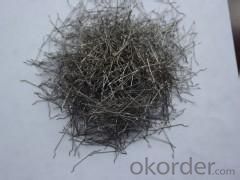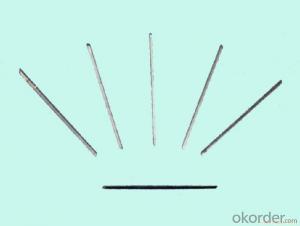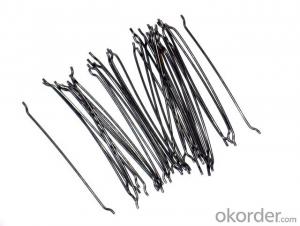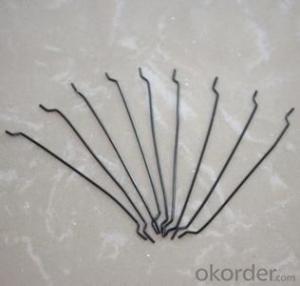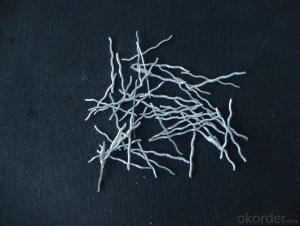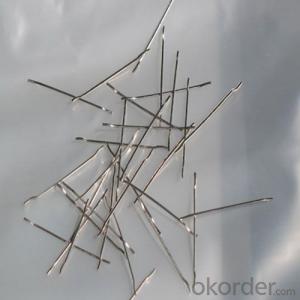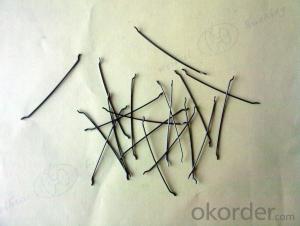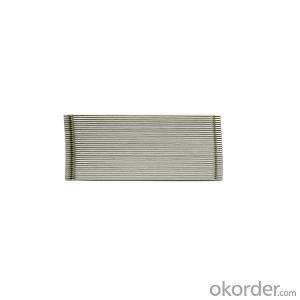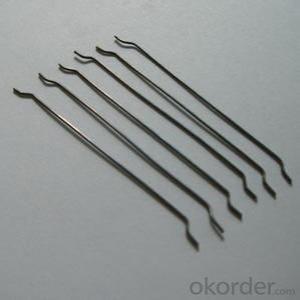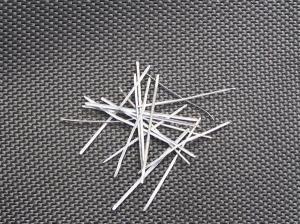Melt Extract Stainless Steel Fiber Reinforced Bending CNBM China
- Loading Port:
- Tianjin
- Payment Terms:
- TT OR LC
- Min Order Qty:
- 1000 kg
- Supply Capability:
- 250000 kg/month
OKorder Service Pledge
OKorder Financial Service
You Might Also Like
Quick Details
Dimensions: steel wire
Grade: steel wire
Application: for concrete reinorcement
Shape: clear and bright
material: steel wire
type: wavy steel fiber
shape: corrugated flat fiber
usage: concrete reinforcement
appearance: clear and bright
Place of Origin: Shandong, China (Mainland)
Product features
steel fiber are for concrete construction, greatly improves concrete bonding and tensile strength .
concrete steel fiber is specially designed to enhance concrete in it`s hardened state ,the uniform distribution of steel fibers throughout the concrete greatly improves concrete bonding and tensile strength ,additionally it provides exceptional load stability and durability .
as reliable and efficient concrete reinforcement material ,it is widely uesd in buildings ,bridges ,thin roof engineering ,highway etc.
Specifications
Diameter :0.5-1.2mm
Tensile strength :≥1100Mpa
Length :20-60mm
properties :excellent tensile ,high tenacity ,against cracking and fatigue
type :any type we can produce according to your request
Picture
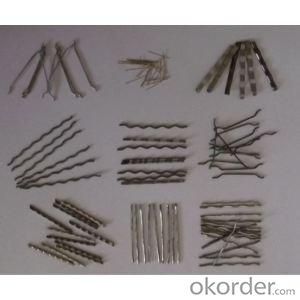
steel fiber concrete reinforced
FAQ
we can produce any type steel fiber and of course we can make production according to your requirement
we have specilize in this field for almost 10 years ,with good quality and competitive price
- Q: Can melt extract stainless steel fiber be used in roller-compacted concrete (RCC)?
- Yes, melt extract stainless steel fiber can be used in roller-compacted concrete (RCC). RCC is a type of concrete that is compacted using rollers, which provides a denser and more durable finished product. The addition of stainless steel fibers in RCC can enhance its mechanical properties, such as resistance to cracking and improved flexural strength. Melt extract stainless steel fibers are produced by melting stainless steel and then rapidly extracting it into fine fibers. These fibers have high tensile strength, corrosion resistance, and can effectively distribute stresses within the concrete matrix. As a result, they can enhance the performance of RCC by improving its resistance to shrinkage, impact, and fatigue. Furthermore, melt extract stainless steel fibers are easily dispersed in the concrete mixture and can be evenly distributed throughout the RCC during the compaction process. This ensures that the fibers are well-bonded with the concrete matrix, providing uniform reinforcement and preventing the formation of cracks. In summary, the use of melt extract stainless steel fiber in roller-compacted concrete is a suitable option to enhance its mechanical properties and overall durability. However, it is important to consult with concrete experts and conduct proper testing to determine the appropriate dosage and fiber length for the specific RCC application.
- Q: Are there any guidelines or standards for using melt extract stainless steel fiber in construction?
- Construction projects involving melt extract stainless steel fiber must adhere to guidelines and standards. ASTM A820 is the primary standard governing the use of stainless steel fiber in construction. This standard outlines guidelines for classifying, determining chemical composition, and assessing mechanical properties of stainless steel fibers used for concrete reinforcement. According to ASTM A820, stainless steel fibers must meet specific criteria for diameter, length, and tensile strength. The standard also specifies the minimum fiber content necessary to achieve the desired reinforcement effect when added to concrete. Aside from ASTM A820, other guidelines and standards exist for the usage of stainless steel fiber in specific applications. The American Concrete Institute (ACI), for example, provides recommendations for employing stainless steel fiber reinforcement in shotcrete and precast concrete elements. It is important to note that while these guidelines and standards offer valuable recommendations, they are not obligatory requirements. The specific requirements for utilizing melt extract stainless steel fiber in construction may differ depending on project specifications and local building codes. Consequently, consulting with design professionals and local authorities is always advisable to ensure compliance with the appropriate guidelines and standards.
- Q: What is the effect of melt extract stainless steel fiber on the workability of shotcrete?
- The workability of shotcrete can be significantly impacted by the utilization of melt extract stainless steel fiber. Melt extract stainless steel fibers are commonly incorporated into shotcrete mixes to enhance its mechanical properties, including tensile strength, toughness, and durability. One of the primary impacts of melt extract stainless steel fiber on shotcrete workability is the enhancement of cohesion and resistance to segregation. By acting as a reinforcement within the shotcrete matrix, the fibers effectively increase its viscosity and prevent the settling of aggregate particles. As a result, a more uniform mixture is achieved, which is easier to handle and apply. Furthermore, the addition of melt extract stainless steel fibers can improve the overall consistency and pumpability of shotcrete. The fibers serve as a lubricant, reducing friction between particles and facilitating smoother pumping and spraying. Consequently, the workability is improved, as the shotcrete can be maneuvered more easily into intricate shapes and confined spaces. Moreover, melt extract stainless steel fibers have the ability to enhance the bond strength between shotcrete and the substrate. Through the creation of a mechanical interlock with the substrate, the fibers increase adhesion and prevent delamination. This not only improves workability during application but also enhances the long-term durability and performance of the shotcrete. It is worth noting that the impact of melt extract stainless steel fiber on shotcrete workability may vary depending on factors such as fiber dosage, length, aspect ratio, and mix design. Thus, it is essential to carefully consider the specific requirements of the project and seek guidance from experienced professionals to determine the optimal fiber dosage and mix proportions for achieving the desired workability and performance.
- Q: Can melt extract stainless steel fiber be used in tunneling and underground construction?
- Certainly! Melt extract stainless steel fiber proves to be a suitable option for tunneling and underground construction endeavors. Renowned for their exceptional tensile strength, resistance to corrosion, and prolonged durability, stainless steel fibers are an optimal choice for reinforcing concrete structures. In the realm of tunneling and underground construction, where structures endure significant stress levels such as impact and vibration, utilizing stainless steel fiber can bolster the structural integrity and elongate the lifespan of the construction. Moreover, stainless steel fibers also offer enhanced crack resistance and fire resistance, both of which are pivotal in subterranean environments. All in all, melt extract stainless steel fiber emerges as a dependable and efficacious reinforcement material for tunneling and underground construction projects.
- Q: Can melt extract stainless steel fiber be used in lightweight concrete?
- Yes, melt extract stainless steel fiber can be used in lightweight concrete. The fiber helps to enhance the strength, durability, and crack resistance of the lightweight concrete while also providing reinforcement.
- Q: Is melt extract stainless steel fiber suitable for use in high-performance mortar?
- Yes, melt extract stainless steel fiber is suitable for use in high-performance mortar. Stainless steel fibers are known for their exceptional strength, durability, and corrosion resistance, making them ideal for applications that require high-performance materials. When added to mortar, these fibers can enhance the overall performance of the mortar by improving its tensile and flexural strength, reducing cracking, increasing impact resistance, and enhancing durability. Additionally, melt extract stainless steel fibers have a high melting point, which allows them to withstand high temperatures without losing their mechanical properties. This makes them particularly suitable for high-performance applications where the mortar will be exposed to extreme conditions or thermal stresses. Overall, melt extract stainless steel fiber can significantly improve the performance and lifespan of high-performance mortar.
- Q: Can melt extract stainless steel fiber be used in combination with other types of reinforcement?
- Yes, it is possible to use melt extract stainless steel fiber alongside other forms of reinforcement. In concrete, stainless steel fiber is commonly employed as a supplementary reinforcement to enhance its mechanical properties. These properties include ductility, toughness, and resistance to cracking. To optimize the performance of concrete structures, stainless steel fiber can be combined with other forms of reinforcement, such as steel rebars or synthetic fibers. By combining various types of reinforcement, a synergistic effect can be achieved, leading to improved strength and durability. However, it is crucial to carefully consider the compatibility and suitability of different reinforcement materials. Additionally, the design and construction requirements must be taken into account to ensure proper integration and optimal performance.
- Q: Can melt extract stainless steel fiber be used in high-strength concrete mixtures?
- Yes, melt extract stainless steel fiber can be used in high-strength concrete mixtures. Stainless steel fibers offer several advantages when added to concrete, including increased tensile strength, crack resistance, and durability. The melt extract process ensures that the fibers have a uniform shape and size, which enhances their performance in the concrete mix. The high-strength concrete mixtures require reinforcement to better withstand heavy loads and reduce the risk of cracking, and stainless steel fibers can effectively fulfill this role. Additionally, the corrosion resistance of stainless steel fibers makes them suitable for use in high-strength concrete mixtures, even in harsh environments. Overall, melt extract stainless steel fibers can enhance the properties of high-strength concrete, making it a reliable and durable material for various construction applications.
- Q: What is the typical fiber length and diameter of melt extract stainless steel fiber?
- The typical fiber length and diameter of melt extract stainless steel fiber can vary depending on the specific manufacturer and product, but generally, the fiber length ranges from 10 to 25 millimeters, while the diameter ranges from 20 to 50 micrometers.
- Q: How does melt extract stainless steel fiber improve the durability of marine concrete?
- Several key mechanisms contribute to the improved durability of marine concrete with the addition of melt extract stainless steel fiber. Firstly, the inclusion of these fibers enhances the overall strength and toughness of the concrete, making it more resistant to cracking and spalling in the harsh marine environment. Acting as reinforcement, the fibers provide additional tensile strength to the concrete and prevent the propagation of cracks. Additionally, the corrosion resistance of stainless steel fibers plays a crucial role in improving the durability of marine concrete. Traditional reinforcement materials like steel bars are susceptible to corrosion from saltwater and chloride ions found in marine environments. However, stainless steel fibers are highly resistant to corrosion, ensuring the long-term integrity and durability of the concrete structure. Another significant advantage of melt extract stainless steel fiber is its ability to enhance the resistance of marine concrete to impact and abrasion. As a sacrificial layer, the fibers absorb and dissipate the energy from impacts such as waves or floating debris, which could otherwise damage the concrete surface. This results in a more durable concrete structure that can withstand the harsh conditions of marine environments over a longer period. In addition to these mechanical properties, melt extract stainless steel fiber also improves the durability of marine concrete by reducing shrinkage and improving dimensional stability. This is particularly important in marine applications where the concrete is exposed to wet-dry cycles and extreme temperature variations. By minimizing shrinkage and reducing the potential for cracking, stainless steel fibers contribute to the longevity of the concrete structure. Overall, the incorporation of melt extract stainless steel fiber significantly enhances the durability of marine concrete by improving strength, corrosion resistance, impact resistance, and dimensional stability. These properties ensure that the concrete can withstand the demanding conditions of marine environments, leading to a longer service life and reduced maintenance costs.
Send your message to us
Melt Extract Stainless Steel Fiber Reinforced Bending CNBM China
- Loading Port:
- Tianjin
- Payment Terms:
- TT OR LC
- Min Order Qty:
- 1000 kg
- Supply Capability:
- 250000 kg/month
OKorder Service Pledge
OKorder Financial Service
Similar products
Hot products
Hot Searches
Related keywords



